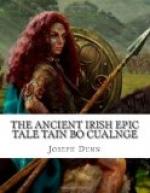These apparent synchronisms, of course, may only rest upon the imagination of the Christian annalists of Ireland, who hoped to exalt their ancient rulers and heroes by bringing them into relation with and even making them participate in the events of the life of the Saviour. But in placing the date of the expedition of the Tain at about the beginning of the Christian era, Irish tradition is undoubtedly correct, as appears from the character of the civilization depicted in the Ulster tales, which corresponds in a remarkable degree with what authors of antiquity have recorded of the Celts and with the character of the age which archaeologists call “la Tene,” or “Late Celtic,” which terminates at the beginning of the first century of our era. Oral tradition was perhaps occupied for five hundred years working over and developing the story of the Tain, and by the close of the fifth century the saga to which it belonged was substantially the one we have now. The text of the tale must have been completed by the first half of the seventh century, and, as we shall see, its oldest extant version, the Book of the Dun, dates from about the year 1100.
But, whatever may be the precise dates of these events, which we are not in a position to determine more accurately, the composition of the Tain Bo Cualnge antedates by a considerable margin the epic tales of the Anglo-Saxons, the Scandinavians, the Franks and the Germans. It is the oldest epic tale of western Europe, and it and the cycle of tales to which it belongs form “the oldest existing literature of any of the peoples to the north of the Alps."[7] The deeds it recounts belong to the heroic age of Ireland three hundred years before the introduction of Christianity into the island, and its spirit never ceased to remain markedly pagan. The mythology that permeates it is one of the most primitive manifestations of the personification of the natural forces which the Celts worshipped. Its historical background, social organization, chivalry, mood and thought and its heroic ideal are to a large extent, and with perhaps some pre-Aryan survivals, not only those of the insular Celts of two thousand years ago, but also of the important and wide-spread Celtic race with whom Caesar fought and who in an earlier period had sacked Rome and made themselves feared even in Greece and Asia Minor.




